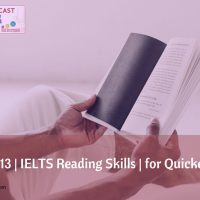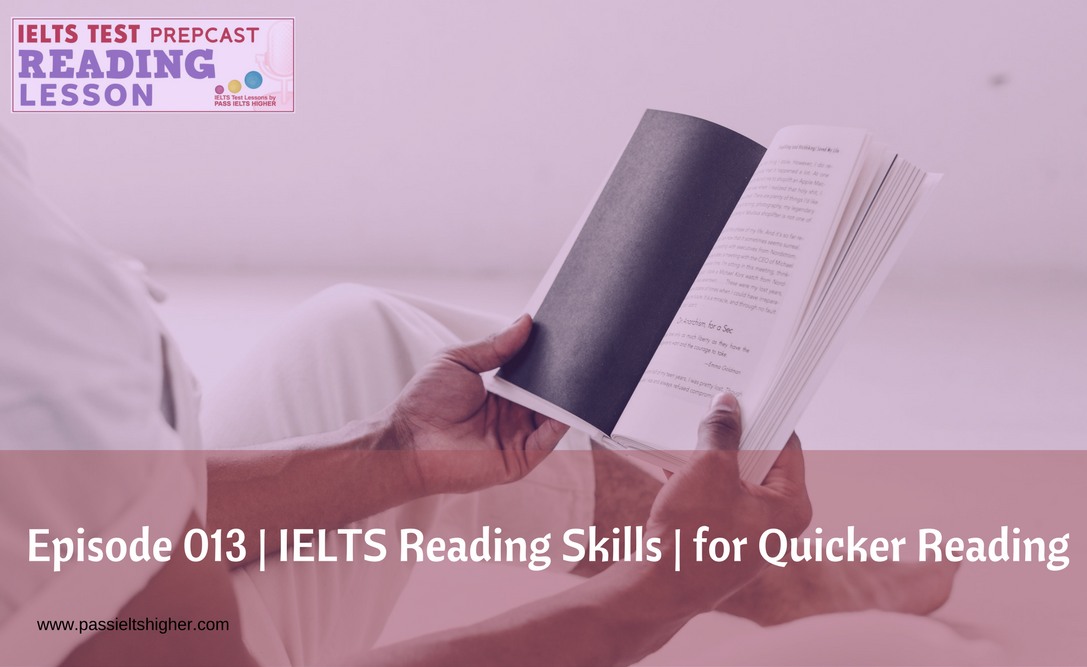
- Social:
- Link:
Most students have difficulty with IELTS Reading when they start IELTS. Smart students recognise this and prepare well – learning key techniques which will help them and save time in the test.
Understanding how to do this is a key skill for IELTS Test candidates and band scores can only rise higher once effective techniques are learned and used.
Click here to be taken to iTunes where you can subscribe to all of the IELTS Test Prepcasts.
Podcast Transcript
IELTS Test Prepcast Episode 13
IELTS Listening Skills: Signpost Words
I’m Steve Price. I’m the founder of the Pass IELTS Higher website, which was started in late 2010 and has been successfully helping students achieve higher band scores since. Andrea Price currently lives and works in London, teaching IELTS. She has been teaching the subject at home and abroad for over twenty years.
And now for today’s IELTS lesson.
Steve: Hello. Today we’re going to talk about IELTS reading, and in particular we’re going to talk about the techniques that students need to learn and practice and implement during their IELTS test. I’ve got with me Andrea, and she’s going to take us through the techniques that she teaches.
Andrea: Hi. I’m always getting students who ask me, “I’m not getting the right band score for my reading. What can I do? There’s just a lot to read and not enough time to do it. How on earth can I make myself read more quickly?” For that reason, I’ve created a little booklet, and inside that booklet are what I’m calling reading techniques 1 and reading techniques 2. I find that students like some sort of format or formula to help them read more quickly, and I hope that this booklet does it. I do know that it works because I’ve had a couple of students who come back to me—and I’m sure many more as well, but they just haven’t spoken to me—and these students went away, took my table away. And with lots of practice using my table—they were both Chinese—one came back with a band 9 after using the table, and one came back with an 8.5. So you can see that it works. Of course, this is only my advice. There are other ways; you will be taught other ways to read more quickly. But not saying you have to use mine. It is a good way, but if you try it and don’t like it, then you just need to learn how to do things in another way.
Steve: Okay. Just so we’re being clear there and being transparent with our listeners, you obviously sell this book that you’ve prepared, and if I’m right, you sell it on Amazon Kindle. Is that right?
Andrea: Yes, that’s right.
Steve: Okay.
Andrea: If you want to look for it, it’s called IELTS Reading Techniques: Improve Your IELTS Band Score, and it does. All you need to do is answer two more questions to get an extra .5 of a band score. And the students often come in w a 6.5 and they really need a 7, so it’s very easy just to get two more. And hopefully, this table will help you do it.
Steve: Okay.
Andrea: So it’s divided into two, and it’s divided into certain kinds of questions. All the IELTS candidates will be familiar with the kinds of questions there are. In this reading booklet, I focus on eleven kinds of questions, although there are in fact more.
For some questions, you need to read the text first, and in my booklet, I’ve told you that, why don’t you try reading the text first for four kind of questions? And the four kinds of questions are matching headings. So I’m just going to call them what they’re called in the course book. Students will know anyway what they mean.
Question type number 1 is called “matching headings”. Here you have to match the headings to each paragraph.
Question type 2 is classification, so you’ve got to analyse questions according to certain sorts of classification. For example, it might be people with red hair, people with black hair, people with blond hair, people with none. So that’s what they mean by classification, and then you have to answer your questions according to these classifications.
Question type 3 is locating information in paragraphs, so they give the, the examiner gives you information, and you have to find that information which paragraph is that information in and question 4 is called “matching list of people”, and they quite often will give you certain professions. For example, psychologist. And they will give you opinions of these psychologists. I’ll give you a list of the people, and you’ll have to decide which opinions belonging to which kinds of people.
For these four questions, I recommend that you read the passage first. Of course, you don’t read the whole passage, because even a native speaker wouldn’t really remember the whole passage. You break the passage down into paragraphs, and what you try to do is summarise a paragraph in your head. Do you know the general idea of what the paragraph is saying? You then go and look at the questions and match your questions to that paragraph, but the whole idea is that you read the paragraph first and then answer the questions.
Steve: Okay. So I guess what we’re assuming there is that when they’re breaking the questions down into paragraphs that the—or rather reading and the paragraphs—that the questions are going to have some sort of order, some sort of linear order, that reflects the paragraphs in which they appear.
Andrea: No. That’s a good question. It’s going to happen in reading techniques 2. In reading techniques 1, the whole reason for reading the paragraphs first is that it’s easier. For example, you’ll be given seven questions, and if you read the questions first, you’ll have to read the text seven times. But if you read the paragraphs first, you’ll only need to do it once for each question.
Steve: Ah, I see. So it’s an efficient way of being able to answer it.
Andrea: Yes.
Steve: So instead of having to keep on going back to the paragraph and reading it again and again and again, what you’re doing is you’re reading it once, hoping that you retain enough of it to answer some of the questions or at least know where those answers are residing in the paragraph.
Andrea: Yes, exactly that. And the whole idea, anyway, it’s the whole—I think the basis of IELTS really is that you look at the keywords and you find paraphrases. Obviously, that’s what you’ve got to do in each skill, and this is what we’re focusing on here. So you’d read paragraph 1, have an idea of it in your head, a general idea, but that while you are reading it, you will have underlined keyword. You then go and look at the questions, look at the keywords, which keywords belong to that paragraph.
Steve: Okay.
Andrea: Okay. So that’s for four kinds of questions, but I’ll just reiterate that then the questions are not in order because the paragraphs are in order.
Steve: Okay.
Andrea: There’s then a second approach with the seven other questions I’ve included, and here I suggest you read the question first, and all you need to do is read the question, underline the keywords, and then you go to the text, and you’ll have to scan—skim or scan, whatever you like to think, but read very quickly—and find exactly the paraphrase. Once you find the paraphrase, you can answer your question, and after that, then the questions are in order. So your questions are in order in the ones I’m about to tell, and that’s in my reading techniques 2 approach.
Steve: Okay. And both of these are covered in your table.
Andrea: It’s in my table, yes. Right, so I think where you can read the questions first, and especially where you’re pulling out the keywords, are in these following types of questions. True, false, not given or the yes, no, not given. These are in almost every reading section, and again, these are the ones that will give you your higher band scores, so it’s good to practice these. And once you find your keywords in the question, if you’re paraphrasing the text, and then questions are in order, and it’s the same for all of the following. Sentence completion, summary completion, summary completion with a box—so these are what they’re always called in the course box—and matching sentence endings.
There are also multiple-choice questions and completing a flow chart or a diagram or a table. And those are basically the eleven kinds of questions that you will find in a reading exam.
Steve: Okay. And you’ve mentioned earlier that there are more, that these are the ones that you’re focusing on.
Andrea: I focused on these.
Steve: Yes.
Andrea: The reason for that is that this table links to Cambridge book 7. And there’s another book that’s called Cambridge book 7. And you need to read the text, and then I give the answers and keywords and synonyms that help you find the answers.
Steve: I see. So in this case, you’ve actually got another book which is basically explaining to students why the answers in the Cambridge IELTS book student questions or exam questions—I’m sorry, what’s the name of the book? It’s the Cambridge IELTS 7 Test Questions, is that?
Andrea: Yes.
Steve: Yes. So your other book actually takes you through that and explains why each of the answers is correct.
Andrea: Yes, exactly. And this one is very useful. When you listen to all the prepcasts, every time we speak about it, you’ll hear that what you really need to improve your IELTS band score is a wide knowledge of keywords and their paraphrases or their synonyms or sometimes their opposites, their antonyms. And obviously, the more of these you’ve got, the easier any of those IELTS questions are going to be.
Steve: I see. Okay. So in terms of our objective today in just telling people about the general reading techniques that we could use, I think we’ve probably covered the sorts of questions that they should expect to encounter. We’ve also outlined some techniques, which in terms of reading your questions first or reading your questions last—so either reading the, writing the paragraph first or reading the paragraph last—so we’ve matched up questions you are likely to encounter with techniques which are most appropriate for answering those questions quickly. And I guess what we’ve also discovered is that you’ve got a couple of books, one of which is teaching you general approaches to IELTS reading techniques, and the other one is actually specific to Cambridge IELTS 7, which most of the IELTS test candidates will be familiar with. But that one explains why the answers in Cambridge IELTS 7 reading are correct.
Andrea: Yes.
Steve: So it gives them a better understanding than the Cambridge IELTS 7 book does.
Andrea: Yes, because the book 7, the Cambridge books don’t explain why their answers are correct. And obviously, if you understand why the answers are correct, you’ve then got more vocabulary. You’ve got more keywords and paraphrases and that you can go away and use these and recycle them in reading, listening, writing, or speaking.
Steve: Yes. So if they, if people want to go and buy that, they can obviously go to the Amazon Kindle Store and search for your name. I imagine if you type in “Andrea Price”, I imagine that they’ll, that those books will come up.
Andrea: Yes
Steve: Okay. And what we’ll also do is we’ll put a link on the show page for this episode as well. Okay, in terms of today’s objectives I think we’ve covered that. And thank you very much. Until next time.
Andrea: Okay. Bye-bye.


Leave a Reply